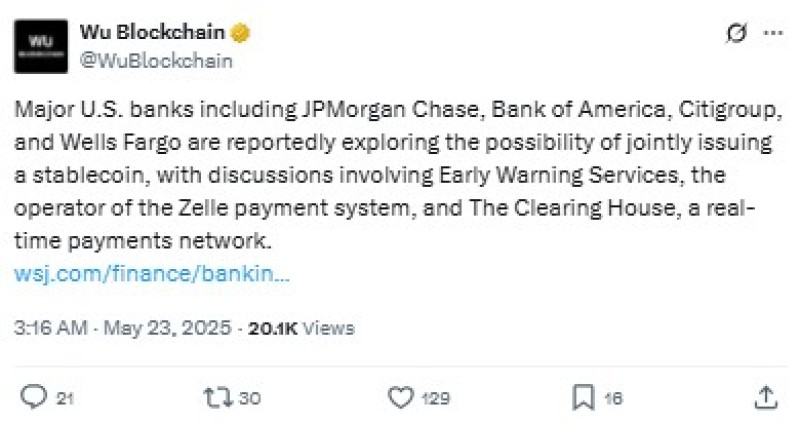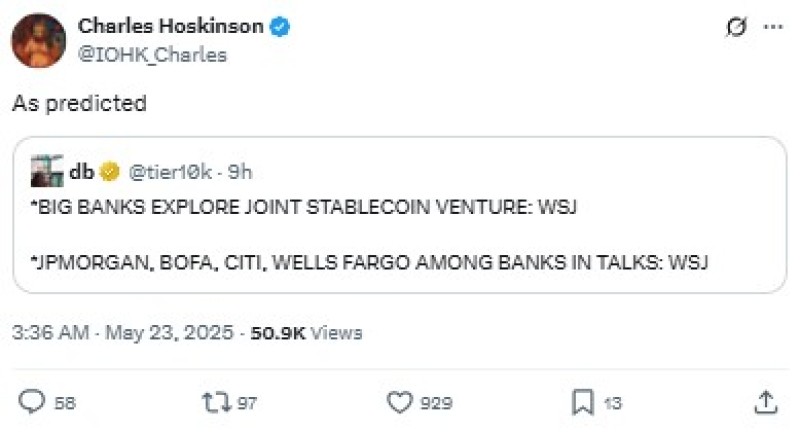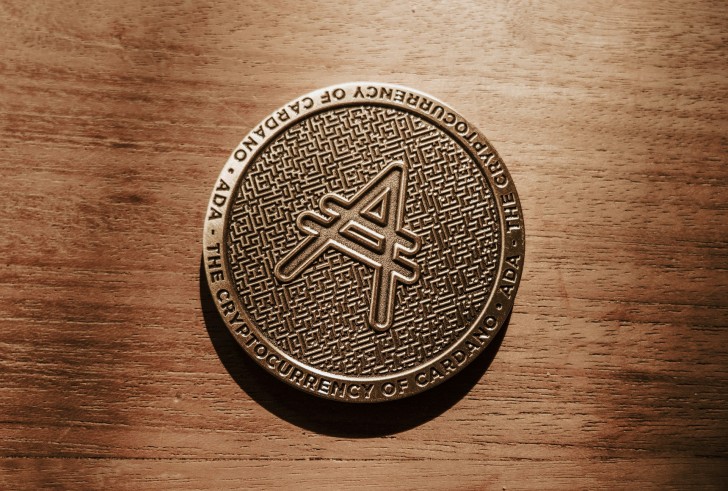- ADA's Chief Called It: Banks Finally Getting on the Crypto Train
- Big Banks Go Full Crypto Mode: What This Means for ADA
- ADA Positioned to Win as Stablecoin Wars Heat Up
- Cardano's Long Game Finally Paying Off
- The "I Told You So" Moment Crypto's Been Waiting For
- What Happens Next for ADA and the Crypto World
Cardano (ADA) founder Charles Hoskinson is having his "I told you so" moment as JPMorgan, Bank of America, and other banking giants explore launching their own stablecoin, potentially shaking up the $243 billion market.
ADA's Chief Called It: Banks Finally Getting on the Crypto Train
Charles Hoskinson just dropped the most satisfying "As predicted" tweet of his career, and honestly, the guy's earned his bragging rights. The Cardano (ADA) founder and IOG mastermind has been saying for years that big banks would eventually cave and embrace crypto – and now it's actually happening.
The Wall Street Journal just broke the news that sent shockwaves through the crypto world: America's biggest banks are seriously talking about teaming up to launch their own stablecoin. We're talking JPMorgan Chase, Wells Fargo, Bank of America, and Citigroup – the absolute heavyweights of traditional finance who've spent years treating crypto like it had the plague.

For Hoskinson, this isn't just vindication – it's proof that his long-term vision for Cardano (ADA) as a bridge between old-school finance and blockchain tech was spot-on. While other crypto projects were busy trying to "stick it to the banks," Hoskinson was quietly building infrastructure that these same institutions might actually want to use.
The timing couldn't be more perfect either. With Trump's pro-crypto administration setting the tone and a stablecoin regulatory bill just passing a major Congressional hurdle, the stars are finally aligning for mainstream crypto adoption. It's like watching all the dominos Hoskinson set up years ago finally starting to fall.
Big Banks Go Full Crypto Mode: What This Means for ADA
Here's the thing that's got everyone buzzing – this isn't just one rogue bank dipping its toes in crypto waters. We're talking about a full-blown consortium including some of the most conservative financial institutions in America. Even Zelle (yeah, the payment app your mom uses) and the Clearing House payment network are getting in on the action.
These talks are still in the early stages, so things could change, but the fact that these conversations are even happening is mind-blowing. Just a few years ago, these same banks were calling Bitcoin "rat poison" and warning customers away from crypto. Now they're basically admitting they can't ignore it anymore.
The motivation is pretty obvious – they're getting their lunch eaten by crypto companies and fintech startups. While banks were sitting around debating whether crypto was "real money," companies like Tether built a $152 billion empire out of thin air. Now the traditional finance world is scrambling to catch up before they become completely irrelevant.
What's really interesting is how this validates Cardano's approach. While other blockchains were focusing on being anti-establishment, ADA was building the kind of enterprise-grade, regulatory-compliant infrastructure that these banks actually need. Suddenly, Hoskinson's focus on academic rigor and playing nice with regulators doesn't look so boring after all.

ADA Positioned to Win as Stablecoin Wars Heat Up
The current stablecoin game is basically Tether's world with everyone else fighting for scraps. USDT controls about $152 billion of the $243 billion total market, but that could change fast if big banks start playing. Think about it – would you rather hold a stablecoin backed by some mysterious offshore company or one issued by JPMorgan Chase?
Ripple clearly saw this coming too, launching their RLUSD stablecoin in December 2024 specifically targeting enterprise clients. Even Meta is getting back in the game after their Libra project face-planted spectacularly back in 2019-2020. When everyone from banks to tech giants to crypto companies are all rushing into stablecoins, you know something big is happening.
For Cardano (ADA), this is like Christmas morning. The platform's whole value proposition has been about bridging traditional finance with blockchain tech, and now traditional finance is finally ready to build that bridge. All those years of focusing on compliance, sustainability, and academic research instead of just pumping token prices might actually pay off.
The crypto community is already speculating about what happens next. One particularly savage comment on Hoskinson's tweet said "Rip circle and tether we hardly knew ye," suggesting that bank-issued stablecoins could steamroll the existing players. That might be a bit dramatic, but it's not completely crazy either.
Cardano's Long Game Finally Paying Off
Here's what separates Hoskinson from a lot of other crypto founders – the guy actually understands traditional finance. While others were busy tweeting about "banking the unbanked" and "destroying the Federal Reserve," he was building something that banks might actually want to use.
This institutional embrace of crypto doesn't just validate Cardano's technical approach – it validates the entire philosophy behind it. Instead of positioning crypto as the enemy of traditional finance, Hoskinson always argued it should be a complement and upgrade to existing systems.
That strategy is looking pretty smart right about now. As banks start looking for blockchain partners to power their stablecoin initiatives, they're probably not going to choose the platform whose community spends all day tweeting about overthrowing the financial system. They're going to want something reliable, compliant, and built by people who understand their business.
Cardano's focus on peer-reviewed research and gradual, methodical development used to get mocked as "too slow" by the "move fast and break things" crowd. But when you're dealing with institutions that handle trillions of dollars, "slow and steady" starts looking a lot more attractive than "YOLO to the moon."
The "I Told You So" Moment Crypto's Been Waiting For
Charles Hoskinson's two-word tweet might seem simple, but it carries years of being called boring, too academic, or not revolutionary enough. Every time some DeFi protocol got hacked or some meme coin crashed 99%, traditional finance skeptics would point and say "See? This is why crypto isn't ready for prime time."
Well, guess what? The biggest, most conservative banks in America just decided crypto is ready for prime time. They wouldn't be having serious conversations about launching stablecoins if they thought blockchain was just a fad or a scam.
This moment also highlights how much the regulatory landscape has shifted. With clearer rules emerging and a crypto-friendly administration in power, banks finally have the cover they need to get serious about digital assets. No more hiding behind "regulatory uncertainty" as an excuse to sit on the sidelines.
The ripple effects (pun intended) could be massive. Once banks start issuing their own crypto assets, it becomes a lot harder for other institutions to justify staying away. Corporate treasuries that have been too scared to hold Bitcoin might be perfectly comfortable holding JPMCoin or whatever these banks end up calling their tokens.
What Happens Next for ADA and the Crypto World
This banking pivot isn't just about stablecoins – it's about legitimacy. When JPMorgan Chase decides crypto is worth taking seriously, every other financial institution has to at least consider whether they're missing out on something big.
For Cardano (ADA), this could unlock the kind of institutional partnerships that Hoskinson has been positioning for since day one. Banks launching stablecoins will need blockchain infrastructure, compliance frameworks, and technical expertise – all areas where ADA has been quietly building advantages.
The interesting part will be watching how existing crypto players react. Will Tether and Circle fight back with better products, or will they get steamrolled by institutions with deeper pockets and regulatory connections? Will other blockchain platforms scramble to copy Cardano's approach, or will they double down on being the "anti-establishment" alternative?
One thing's for sure – the crypto world just got a lot more interesting. When the biggest banks in America are planning to issue their own tokens, we're not talking about a niche technology anymore. We're talking about a fundamental shift in how the financial system works.
Hoskinson's prediction coming true isn't just a personal win – it's a signal that crypto has finally crossed the chasm from early adopter technology to mainstream financial infrastructure. And for a platform like Cardano that's been preparing for this moment since day one, the timing couldn't be better.
"As predicted," indeed. Sometimes the best revenge is just being right.
 Peter Smith
Peter Smith

 Peter Smith
Peter Smith


